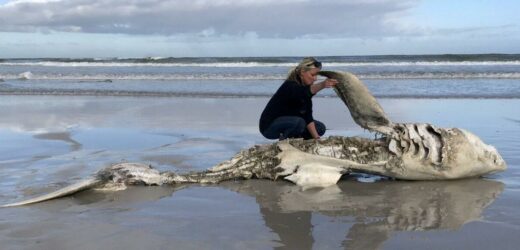Great White shark near Sanctuary Beach minutes after an attack
We use your sign-up to provide content in ways you’ve consented to and to improve our understanding of you. This may include adverts from us and 3rd parties based on our understanding. You can unsubscribe at any time. More info
Since 2017, a pair of male orcas have terrorised the Gansbaai coast in South Africa, which used to be a popular site for great white sharks to live and hunt. These creatures have killed a number of sharks and consumed their oil-rich livers and occasionally hearts, as experts study the carcasses of the fearsome predators that wash up on shore.
While orcas are notorious for devouring everything from small fish to the occasional blue whale, scientists have warned that these killer whales are now having a major impact on their habitat.
In a new study published in the African Journal of Marine Science, researchers have found that great white sharks have been avoiding the region ever since the two killer whales took over.
Through a combination of tagging data and long-term shark sightings, the scientists found that the sharks, who used to be dominated along the Gansbaai coast, have been actively avoiding the region.
Lead study author Alison Towner, a senior biologist studying white sharks at the Dyer Island Conservation Trust in South Africa, said in a statement: “What we seem to be witnessing though is a large-scale avoidance strategy, mirroring what we see used by wild dogs in the Serengeti in Tanzania, in response to increased lion presence.
“The more the orcas frequent these sites, the longer the great white sharks stay away.”
The researchers added that have never seen anything like the attacks before.
Ms Towner wrote: “They work together and tear the shark open by the pectoral fins, ripping it open.”
She then added that the ecosystem of the region had already begun “shifting” to make up for the absence of the great white sharks.
Despite reaching up to 16 feet (4.9 meters) in length, and being armed with several rows of up to 300 serrated, dagger-like teeth, the great white sharks were no match for the orcas that descended on the coast.
Local whale watchers have nicknamed the new apex predators as Port and Starboard, owing to the fact that one of them has its right dorsal fin collapsed while the other has its fin pointing to the left.
The researchers found that as early as sixth months following the death of the first shark, daily shark sightings at Gansbaai had plummeted from over six sightings per day to just one.
DON’T MISS:
UK’s first gigafactory to ‘ramp up production’ as it strikes EV deal [REVEAL]
UK facing EXODUS after Sturgeon unveils new independence plan [INSIGHT]
Russia has ‘insufficient numbers’ to support Ukraine invasion [REPORT]
They found that even the number of sharks detected after being tagged with electronic transmitters also fell.
Before the menacing orcas came to the region, between three and eight tagged sharks were detected in the area each day, which then plummetted to zero.
Days after the orcas slaughtered a shark, the transmitter signal would reveal that the rest of the fearsome fish sometimes swam hundreds of miles away, and stayed there for six months or more before returning.
Source: Read Full Article





